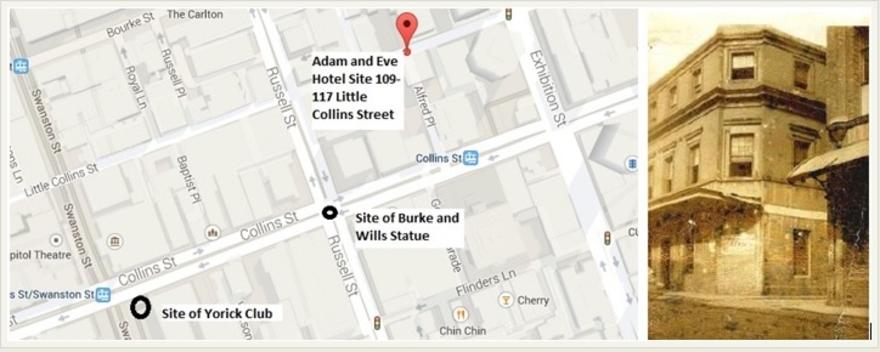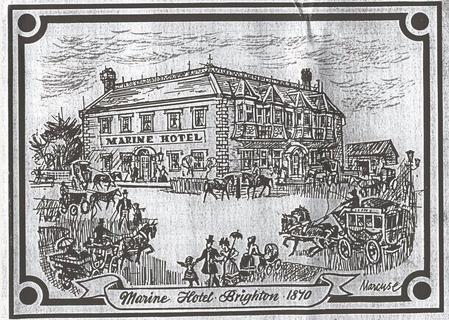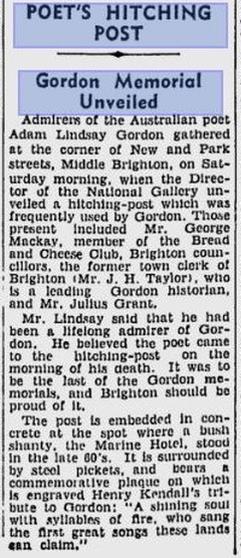RED LION HOTEL HAWTHORN
The Mercury (Hobart, Tas) 3 Aug 1937 p9:
“OLD HOTEL BEING DEMOLISHED
Hawthorn Landmark
MELBOURNE, August 2.
The Red Lion Hotel In Church St., Hawthorn, which was built In 1837, three years before the creation of Hawthorn itself, and was a haunt of Adam Lindsay Gordon, Marcus Clarke, Henry Kendall and George Gordon McCrae, is being demolished. A two-storey building, It was built from bricks made behind the hotel site in the brickyard belonging to its first owner (Mr. C. Souftam). The hotel was a landmark before there were many houses In the district.”

ADAM AND EVE HOTEL
The Adam and Eve Hotel 109-117 Little Collins Street Cnr Albert Place.
Demolished in 1923 for the City Boys News Club. Gordon met Kendall there the day before he committed suicide.
It was a meeting place for members of The Yorick Club.

THE MARINE HOTEL


CLASSIFIED BY THE NATIONAL TRUST

CAULFIELD RACECOURSE
GORDON’S LAST WINNING RACE – 24 June 1869.
Barrier Miner (Broken Hill, NSW) Wed 21 July 1909:
The first Caulfield race meeting of which any record can be found took place on June 24 , 1869. It was advertised at “The Caulfield Races.”
The programme comprised four events, and the stakes totalled £60.
The maiden steeplechase, of three miles, was won by Maid of the Wannon, ridden by Adam Lindsay Gordon. This was the last race won by Gordon, although he raced in approximately 10 more meetings until his death. The last meeting being on 12th March 1870 when he was badly thrown off “Prince Rupert” with head injuries at Flemington VRC Steeplechase “Age” 14/3/70.
The Brisbane Courier Wednesday 16 Oct 1929 p6:
“A BEAUTIFUL RACECOURSE. NEARLY A CEMETERY. CAULFIELD’S NARROW ESCAPE.
By “THE HARVESTER.
MELBOURNE, October 13. 1929
While being shown over the Caulfield racecourse on Saturday last I was informed that once upon a time a public meeting of ratepayers had demanded of the Government of the day that the Caulfield racecourse should be converted into a cemetery. It appears that the old Caulfield Race Club that had the course before the formation of the V.A.T.C . had failed to race on the course for two years, and somebody, apparently not too much in love with racing, conceived the idea of getting rid of the course, and hit upon the cemetery proposal. It seems that the proposal met with a good deal of support, and racing men got a first class fright when it looked as though they might lose the course. Mr. J. G. Heywood, however, got to work, and arranged an immediate meeting, with the result that the club retained the right to race at Caulfield, and eventually the V.A.T.C. took over the course, making it the beautiful place it is to- day. It was a narrow escape. The V.A.T.C took over the course in 1876.”

BRIGHTON DRILL HALL
BRIGHTON ARTILLERY CORPS
Brighton Rifle Company September 1860- Brighton Artillery Corps Royal Victorian Volunteer Artillery Regt 27 February 1866
Disbanded 2 August 1877.
1869 Late Adam Lindsay Gordon Joined The Brighton Artillery Corps. and signed his attestation before Cr.Thomas Wilson (Dingley Dell Museum).
1869 Dec Gordon lent Dr. Murray (Dr to the Brighton Artillery Corps) a book of poems. (Geoffrey Hutton)
Adam Lindsay Gordon committed suicide on Brighton Beach in the early hours of Friday 24th June 1870
Border Watch (Mount Gambier, SA Saturday 2 July 1870 Page 2
Nothing unusual was noticed in Gordon’s manner, except that he seemed more cheerful than was usual with him. He went home about half-past 5 o’clock, and took tea with Mrs. Gordon having taking with him a package of cartridges for his rifle. He spake to Mr.Kelly, with whom he lodged, about going out to practise next morning, as he had made a match to shoot with some person whom he did not name. They also conversed about the Brighton Artillery Corps, of which they both were members. During the evening, and in fact all through the night, Mr. Gordon seemed extremely restless, and was in and out of the house several times, but there was nothing so peculiar in his manner as to excite apprehensions in the mind of his wife or the persons in the house. (end)
Dr. Patrick Murray conducted the post-mortem and stated that he had known Gordon for a year and last was with him 3 days before his death.
Dr. Patrick Murray proved to be a man with no scruples who was publicly disowned by his own father.
Historians have suggested that Dr. Murray could have been an influence in the suicide of Adam Lindsay Gordon.

OLD GEELONG RACECOURSE
4TH MARCH 1869 GORDON RODE “UNION”- UNPLACED
THE GEELONG RACING CARNIVAL AT CONNEWARRE
OVER TWO DAYS- THURSDAY AND FRIDAY 4TH AND 5TH MARCH 1869
This race meeting was attended by H.R.H. Prince Albert, The Duke of Edinburgh on an informal visit to Australia. He was the second son and fourth child of Queen Victoria.This was his second visit to Australia. Previously from 31st October 1867 to 26 June 1868 after closely escaping an assasination attempt in Sydney.
The Governor of Victoria, Sir John Manners-Sutton also attended. The crowd was estimated at 10.000.

At that stage the rail line from Melbourne terminated at Geelong and passage to Connewarre was by horse-drawn coaches and cabs.
Racegoers also came by rail and coach from Ballarat, coach from Colac and by ship from Melbourne and Westernport. In all 10,000 people attended.
A branch line was later opened from just north of the existing Marshall Station to the old racecourse.
The first race meeting to use the line was held on Friday February 1 and Saturday February 2, 1878. On both days a special train left Melbourne at 10:15am, stopping as required in both directions. Trains also ran from Ballarat and Colac to Geelong. On the first day about 1000 passengers travelled on local trains from Geelong to the racecourse.
In 1907 it was decided to relocate the Geelong Racecourse and Geelong Showgrounds to their current site on Breakwater Road, East Geelong due to floodingof the course and financial problems due to distance. The first race meet was held there on March 1908, with the first Geelong Racing Club meet being held there on December 12 1908. The Geelong Racecourse railway station was also provided at this time.

THE HANDICAP STEEPLECHASE, Of 150 sovs. Second horse to receive 10 sovs. out of the stakes. About three miles.
There were seven horses in the race. Adam Lindsay Gordon was on Mr. G Carmichael’s r.g.”Union” aged, 10st. 7lb. The favourite.
A NEWSPAPER DESCRIPTION
“During the race the favorite (Gordon) was running last, but got over all right, although very awkwardly, and from the first it was evident that he was more than likely not to warrant the unbounded confidence reposed in him when he was made such a hot favorite. At the fourth jump he fell, but Gordon kept his seat. It was found, however, that the bridle had broken in the spill, and “Union” went no further.”
Between that meeting and his death on 24th June 1870, 15 month’s later,
Gordon is recorded as attending at least 25 more race and hunt club meetings.
ACKNOWLEDGMENTS-WEB SITES
Rail Geelong.
Rail Geelong-Marshall.
Sparrovale Farm.
Blog by Jo Mitchell.
